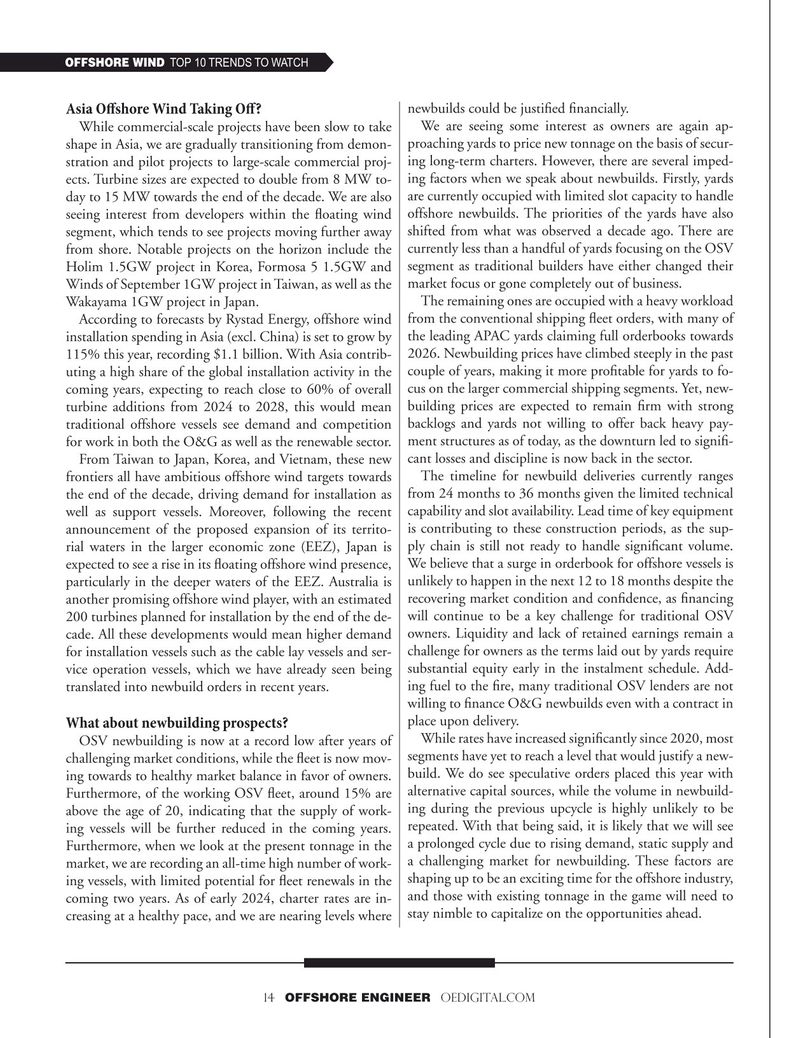
Page 14: of Offshore Engineer Magazine (Jan/Feb 2024)
Read this page in Pdf, Flash or Html5 edition of Jan/Feb 2024 Offshore Engineer Magazine
OFFSHORE WIND TOP 10 TRENDS TO WATCH newbuilds could be justifed fnancially.
Asia Ofshore Wind Taking Of?
While commercial-scale projects have been slow to take We are seeing some interest as owners are again ap- shape in Asia, we are gradually transitioning from demon- proaching yards to price new tonnage on the basis of secur- stration and pilot projects to large-scale commercial proj- ing long-term charters. However, there are several imped- ects. Turbine sizes are expected to double from 8 MW to- ing factors when we speak about newbuilds. Firstly, yards day to 15 MW towards the end of the decade. We are also are currently occupied with limited slot capacity to handle seeing interest from developers within the foating wind offshore newbuilds. The priorities of the yards have also segment, which tends to see projects moving further away shifted from what was observed a decade ago. There are from shore. Notable projects on the horizon include the currently less than a handful of yards focusing on the OSV
Holim 1.5GW project in Korea, Formosa 5 1.5GW and segment as traditional builders have either changed their
Winds of S eptember 1GW project in Taiwan, as well as the market focus or gone completely out of business.
Wakayama 1GW project in Japan. The remaining ones are occupied with a heavy workload
According to forecasts by Rystad Energy, offshore wind from the conventional shipping feet orders, with many of installation spending in Asia (excl. China) is set to grow by the leading APAC yards claiming full orderbooks towards 115% this y ear, recording $1.1 billion. With Asia contrib- 2026. Newbuilding prices have climbed steeply in the past uting a high share of the global installation activity in the couple of years, making it more proftable for yards to fo- coming years, expecting to reach close to 60% of overall cus on the larger commercial shipping segments. Yet, new- turbine additions from 2024 to 2028, this would mean building prices are expected to remain frm with strong traditional offshore vessels see demand and competition backlogs and yards not willing to offer back heavy pay- for work in both the O&G as well as the renewable sector. ment structures as of today, as the downturn led to signif-
From T aiwan to Japan, Korea, and Vietnam, these new cant losses and discipline is now back in the sector. frontiers all have ambitious offshore wind targets towards The timeline for newbuild deliveries currently ranges the end of the decade, driving demand for installation as from 24 months to 36 months given the limited technical well as support vessels. Moreover, following the recent capability and slot availability. Lead time of key equipment announcement of the proposed expansion of its territo- is contributing to these construction periods, as the sup- rial waters in the larger economic zone (EEZ), Japan is ply chain is still not ready to handle signifcant volume. expected to see a rise in its foating offshore wind presence, We believe that a surge in orderbook for offshore vessels is particularly in the deeper waters of the EEZ. Australia is unlikely to happen in the next 12 to 18 months despite the another promising offshore wind player, with an estimated recovering market condition and confdence, as fnancing 200 turbines planned for installation by the end of the de- will continue to be a key challenge for traditional OSV cade. All these developments would mean higher demand owners. Liquidity and lack of retained earnings remain a for installation vessels such as the cable lay vessels and ser- challenge for owners as the terms laid out by yards require vice operation vessels, which we have already seen being substantial equity early in the instalment schedule. Add- translated into newbuild orders in recent years. ing fuel to the fre, many traditional OSV lenders are not willing to fnance O&G newbuilds even with a contract in place upon delivery.
What about newbuilding prospects?
While rates have increased signifcantly since 2020, most
OSV newbuilding is now at a record low after years of segments have yet to reach a level that would justify a new- challenging market conditions, while the feet is now mov- ing towards to healthy market balance in favor of owners. build. We do see speculative orders placed this year with
Furthermore, of the working OSV feet, around 15% are alternative capital sources, while the volume in newbuild- ing during the previous upcycle is highly unlikely to be above the age of 20, indicating that the supply of work- ing vessels will be further reduced in the coming years. repeated. With that being said, it is likely that we will see
Furthermore, when we look at the present tonnage in the a prolonged cycle due to rising demand, static supply and a challenging market for newbuilding. These factors are market, we are recording an all-time high number of work- ing vessels, with limited potential for feet renewals in the shaping up to be an exciting time for the offshore industry, and those with existing tonnage in the game will need to coming two years. As of early 2024, charter rates are in- creasing at a healthy pace, and we are nearing levels where stay nimble to capitalize on the opportunities ahead.
14 OFFSHORE ENGINEER OEDIGITAL.COM

 13
13

 15
15